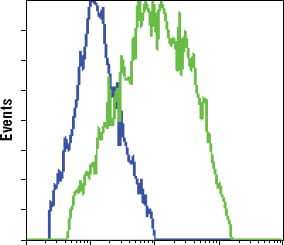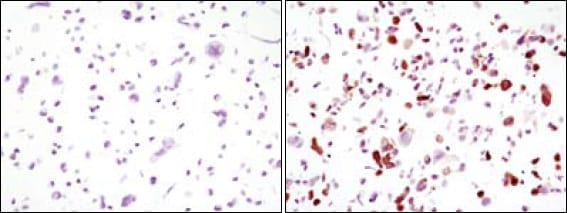

| WB | 1/500-1/1000 | Tag |
| IF | 咨询技术 | Tag |
| IHC | 1/200 - 1/1000 | Tag |
| ICC | 1/100-1/200 | Tag |
| FCM | 1/200 - 1/400 | Tag |
| Elisa | 1/10000 | Tag |
| clone | 4B10B2 |
| WB Predicted band size | 27kDa |
| Host/Isotype | Mouse IgG2a |
| Antibody Type | Tag Antibody |
| Storage | Store at 4°C short term. Aliquot and store at -20°C long term. Avoid freeze/thaw cycles. |
| Species Reactivity | Tag |
| Immunogen | Purified recombinant fragment of GFP expressed in E. Coli. |
| Formulation | Purified antibody in PBS with 0.05% sodium azide |
+ +
以下是3-4篇关于GFP Tag抗体的代表性文献,按研究内容分类整理:
---
### 1. **《Green fluorescent protein as a marker for gene expression》**
**作者**: Chalfie, M. et al.
**期刊/年份**: *Science*, 1994.
**摘要**: 奠基性研究,首次将GFP作为活体报告基因应用于分子标记。虽未直接描述抗体,但为后续GFP标签系统及配套抗体开发奠定基础,推动了针对GFP的抗体在Western blot、免疫荧光等实验中的应用。
---
### 2. **《A comparative study of GFP-binding nanobodies and conventional antibodies》**
**作者**: Rothbauer, U. et al.
**期刊/年份**: *Nature Methods*, 2006.
**摘要**: 比较GFP纳米抗体(单链抗体)与传统多克隆抗体的性能,证明纳米抗体在亲和力、特异性及低背景信号方面的优势,特别适用于活细胞内蛋白相互作用研究及高分辨率成像。
---
### 3. **《Characterization of commercial GFP antibodies for immunoprecipitation and mass spectrometry》**
**作者**: Kirkin, V. et al.
**期刊/年份**: *Molecular & Cellular Proteomics*, 2009.
**摘要**: 系统性评估市售GFP抗体的免疫沉淀(IP)效率及质谱兼容性,为基于GFP标签的蛋白复合物纯化提供抗体选择标准,强调不同品牌抗体在交叉反应性上的差异。
---
### 4. **《GFP-Trap: Affinity purification of GFP-fusion proteins from mammalian cell lysates》**
**作者**: Bürckstümmer, T. et al.
**期刊/年份**: *Nature Protocols*, 2013.
**摘要**: 提出基于GFP纳米抗体的高效纯化方案(GFP-Trap),详述其在哺乳动物细胞裂解液中特异性富集低丰度GFP融合蛋白的流程,适用于蛋白质组学及相互作用研究。
---
**注**:若需具体实验场景的文献(如特定技术优化或跨物种应用),可进一步补充。
Green fluorescent protein (GFP) tag antibodies are immunological tools designed to detect and purify GFP-fused proteins in various experimental systems. GFP, originally isolated from the jellyfish *Aequorea victoria*, emits green fluorescence when exposed to blue light. Its discovery and subsequent engineering (e.g., enhanced GFP, or eGFP) revolutionized molecular and cellular biology by enabling real-time visualization of protein localization, dynamics, and interactions in living cells. To facilitate biochemical analyses, researchers often fuse GFP to target proteins, creating "GFP-tagged" constructs.
GFP-specific antibodies were developed to recognize the GFP epitope, allowing immunodetection or immunoprecipitation of these tagged proteins without requiring protein-specific antibodies. These antibodies bind to conserved regions of GFP or its variants (e.g., eGFP, YFP, CFP), making them versatile across GFP-derived fusion proteins. They are widely used in techniques like Western blotting, immunofluorescence, flow cytometry, and chromatin immunoprecipitation (ChIP). Commercially available GFP antibodies are typically raised in hosts like rabbits or mice, with validation across multiple applications. Their utility extends to tracking exogenous protein expression, validating transgenic models, and studying protein-protein interactions. However, users must confirm compatibility with GFP mutants or related fluorescent proteins (e.g., mNeonGreen), as sequence differences may affect antibody binding. Overall, GFP tag antibodies simplify experimental workflows by providing a universal detection tool for GFP-based fusion systems.
×